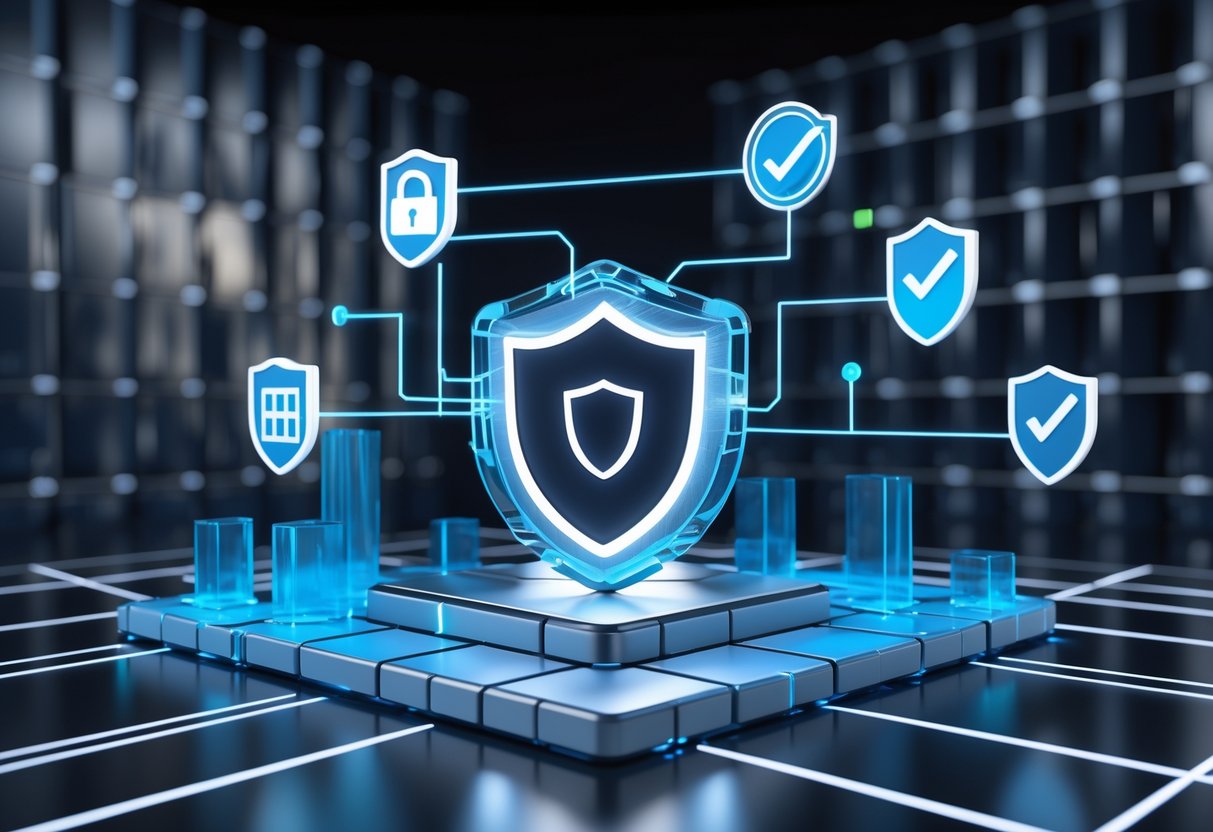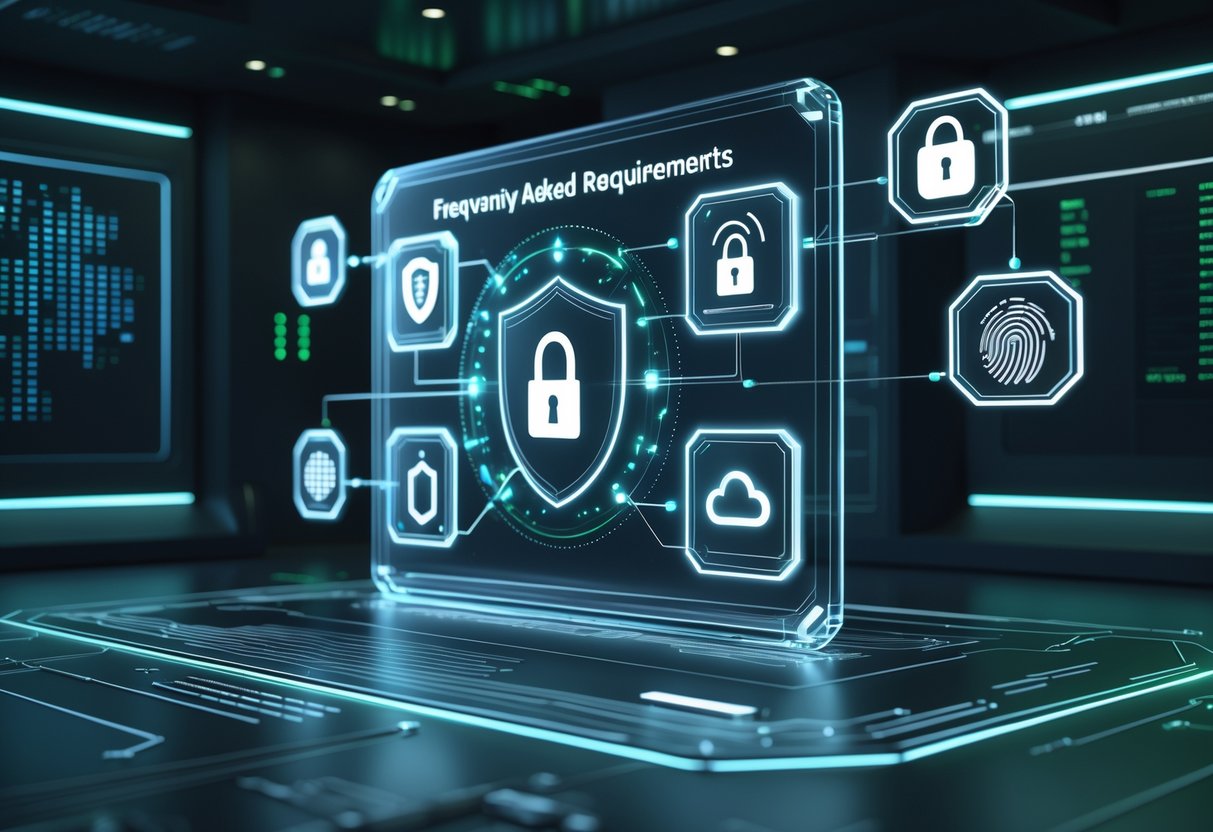Security Requirements: Essential Guide to Policies, Standards & Implementation
Updated On: November 12, 2025 by Aaron Connolly
Core Principles of Security Requirements

Security requirements rest on three main pillars that keep digital systems and data safe. These principles combine to form a security framework that tackles the biggest threats to information.
Confidentiality
Confidentiality keeps sensitive info private and only lets the right people see it. This principle stops data from ending up in the wrong hands.
We see confidentiality in action through a few main ways:
- Encryption scrambles data so only those with permission can read it.
- Access controls decide who gets to see what.
- Authentication checks user identity before letting anyone in.
- Network security blocks unauthorized connections.
Strong passwords are the simplest confidentiality measure. Multi-factor authentication adds another layer by asking for more than just a password.
Data classification helps organizations figure out what needs the most protection. Personal info, financial data, and trade secrets usually need the strictest controls.
Integrity
Integrity makes sure information stays accurate and safe from unauthorized changes. This principle keeps data reliable from start to finish.
Systems use a few main tools to protect integrity:
- Digital signatures prove no one has tampered with the data.
- Checksums spot file changes.
- Version control tracks document edits.
- Backup systems bring back data if something goes wrong.
Input validation blocks bad code from sneaking in. Security updates fix holes that attackers might try to use.
Database integrity rules stop bad data from getting stored. Transaction logs track every change, so it’s possible to undo or trace edits if needed.
Availability
Availability means systems and data stay up and running for people who need them. This principle guards against disruptions that could grind business to a halt.
Some top methods for keeping things available:
- Redundant systems kick in if the main ones fail.
- Load balancing spreads out traffic so nothing gets overloaded.
- Regular backups let you bounce back after a failure.
- Disaster recovery plans help restore services after big incidents.
Network monitoring spots trouble before it causes an outage. DDoS protection blocks attacks that try to flood your systems.
Maintenance happens during slow periods to avoid disrupting users. Service level agreements set the rules for downtime and response times.
Types of Security Requirements
Security requirements fall into four main buckets. Authentication checks who you are, access control decides what you can do, encryption hides data from outsiders, and non-repudiation makes sure actions can be traced back to specific users.
Authentication
Authentication requirements spell out how we prove user identities before giving access. Strong authentication keeps out intruders by demanding real proof—something you know, have, or are.
Multi-factor authentication (MFA) uses more than one check. You might enter a password, get a text code, and scan your fingerprint. This combo slashes security breaches compared to single passwords.
Common authentication methods:
- Passwords and passphrases — old-school but easy to attack.
- Biometric verification — fingerprints, faces, or even eyes.
- Hardware tokens — gadgets that create unique codes.
- Smart cards — encrypted cards that need a PIN.
Authentication requirements should lay out password rules, lockout policies, and session timeouts. Honestly, passwords should be at least 12 characters with numbers and symbols.
Access Control
Access control requirements decide what authenticated users can actually do. The idea is to give people only the access they need—no more.
Role-based access control (RBAC) gives permissions based on job roles. For example, marketing sees customer data, not financials. IT admins handle systems but don’t peek at employee info.
| Access Level | Typical Permissions | Example Roles |
|---|---|---|
| Read-only | View files, reports | Interns, auditors |
| Read-write | Edit assigned data | Regular employees |
| Administrative | User management, system config | IT managers |
Access control requirements need to define roles, permission levels, and review steps. Regular audits keep permissions current when people switch jobs or leave.
Mandatory access control (MAC) locks things down even tighter. The system makes the rules, not the users—think government or military setups.
Encryption
Encryption requirements keep data confidential by turning it into unreadable code. Only those with the right keys can unlock it.
Data at rest encryption protects stored info—servers, databases, backups. AES with 256-bit keys is the go-to for most businesses.
Data in transit encryption guards info as it moves. TLS encrypts web traffic, emails, and file transfers. TLS 1.3 is the best bet right now.
Key encryption requirements:
- Algorithm standards — AES-256 for symmetric, RSA-2048 for asymmetric.
- Key management — safe key creation, storage, and rotation.
- Certificate authorities — trusted sources for certificates.
- End-to-end encryption — keeps data protected the whole way.
Encryption requirements should cover where keys are stored, how often you rotate them, and how to recover them. Bad key management ruins even the best encryption.
Non-Repudiation
Non-repudiation requirements make sure users can’t deny what they did. Digital signatures and audit trails provide proof of who did what and when.
Digital signatures use cryptography to verify documents and sender identity. Signed contracts, transactions, and system changes become binding with the right setup.
Audit logging records everything—logins, file edits, admin changes. These logs help investigate incidents and show compliance.
Key non-repudiation elements:
- Timestamping — logs the exact time of actions using trusted sources.
- User attribution — links actions to real user accounts.
- Data integrity — keeps logs from being changed or erased.
- Long-term storage — hangs onto records for as long as needed.
Non-repudiation requirements should set log retention periods, storage methods, and access rules. Financial orgs usually keep logs for seven years, while healthcare might need even longer.
Standards and Regulatory Compliance

Esports security requirements have to follow industry standards like PCI-DSS for payments and data protection laws such as GDPR. Organizations need clear policies and regulatory frameworks to protect player data and earn trust.
Industry Standards
Industry standards give esports organizations a blueprint for protecting data and proving they’re serious about security. PCI-DSS is a must for any platform handling payments.
SOC 2 compliance is now a big deal for platforms working with enterprise sponsors. Most big brands ask for SOC 2 reports before they sign on.
ISO 27001 certification helps bigger esports orgs show off their security chops. Tournament organizers like ESL and Riot Games often point to these standards in their programs.
Some common standards in esports:
- PCI-DSS: For payment processing.
- SOC 2: Required by enterprise sponsors.
- ISO 27001: Used by major tournament organizers.
- NIST Cybersecurity Framework: Adopted by larger companies.
Policies
Security policies turn standards into real rules for esports teams and orgs. Player data policies have to spell out how info gets collected, stored, and shared.
Tournament platforms need clear incident response plans. When a breach hits during a big event, a fast reaction protects both players and organizers.
Account security policies matter a lot in competitive gaming. Password rules, two-factor authentication, and device management help stop account takeovers.
Anti-cheat policies have to balance security and player privacy. Clear rules help players understand what’s being monitored and why.
Regulations
GDPR has a huge impact on European esports orgs and any platform serving EU players. It covers player consent, data portability, and the right to be forgotten—so tournament signups and streaming have to follow strict rules.
Regional regulations are all over the place. California’s CCPA affects US orgs, and countries like Germany and South Korea have their own gaming laws.
Age verification is a real headache. Many places require parental consent for players under 16, which makes youth tournament signups tricky.
Broadcasting regulations also hit esports streams. Different countries set their own rules for ads, content ratings, and gambling sponsors during live events.
If you don’t comply, the fines can be brutal. GDPR violations can hit €20 million or 4% of annual revenue, so regulatory compliance isn’t optional for growing esports orgs.
Building Security Requirements in the SDLC
To build security requirements into the software development lifecycle, developers need to think like attackers, stakeholders have to care about security from day one, and teams need to check for security at every stage. Security can’t just be an afterthought—it has to be everyone’s job.
Role of Developers
Developers turn security requirements into real code. They need to understand why each requirement matters, both technically and for the business.
Training developers well helps them spot security issues early. They need to know about attack patterns like SQL injection and cross-site scripting. That way, they can write better code from the start.
Code reviews become security checkpoints when devs know what to look for. Teams should use checklists for things like authentication, input validation, and encryption. These reviews catch problems before anything goes live.
Secure coding standards give developers a clear playbook. Guidelines need to cover passwords, encryption, and logging, with code examples that show how to do it right.
Developers also need the right tools. Static analysis tools spot vulnerabilities automatically. Teams should build these into their workflow so every build gets checked.
Security by Design
Security by design means you bake protection into software from the start—not tack it on later. This approach saves time and usually leads to stronger apps.
Requirements gathering has to include security from day one. Teams should ask who will use the system, what data needs protection, and which threats matter most. Business folks can help flag what’s valuable.
Threat modeling lets you see how attackers might break things before you even write code. Mapping out attack paths reveals security needs you might otherwise miss.
Secure architecture decisions set the tone for everything else. Teams need to pick authentication methods, design access controls, and plan for data protection early. These choices affect every feature you build.
Design should cover abuse cases, not just normal use. Asking “how could someone misuse this?” uncovers requirements that protect against accidents and attacks.
Stakeholder Involvement
Involving the right people in security requirements makes sure you protect what really matters. Different stakeholders bring different insights that make security stronger.
Business leaders know which assets need the most protection. They understand regulatory stuff like GDPR or PCI DSS. Their feedback keeps security aligned with business goals.
End users can flag risky workflows. They help balance security with usability—if security is too hard, people will just find workarounds.
Compliance teams make sure you meet legal and regulatory needs. They know which standards apply. Their help saves you from expensive fixes later.
Security analysts have the technical know-how about threats and attacks. They turn business risks into technical requirements. Their approach helps ensure you don’t miss anything important.
Regular stakeholder reviews keep requirements up to date as the project changes. Teams should revisit security needs whenever business priorities shift or new threats pop up.
Threat Assessment and Modelling
Figuring out security risks takes more than just checking boxes. We have to look at our existing vulnerabilities and really think about how attackers might take advantage of them.
These two approaches work hand-in-hand and help us build stronger security requirements.
Threat Assessment
Threat assessment looks at your systems and infrastructure to spot security weaknesses. We dig into potential holes that attackers could use.
We start by listing every system part, data flow, and access point. Then we track where sensitive info lives, how we process it, and how it moves around.
Key assessment areas include:
- Network infrastructure vulnerabilities
- Application security weaknesses
- User access controls and permissions
- Data storage and encryption gaps
- Third-party integrations and dependencies
We go through each vulnerability, asking how bad it could get and how likely it is to happen. That way, we can focus on the biggest risks first.
We use tools like vulnerability scanners and penetration tests to find the technical stuff. But we can’t ignore the human side—social engineering and insider threats are real problems.
Threat Modelling
Threat modelling flips the perspective and asks, “How would I attack this system?” We try to get ahead of attackers by imagining possible attack paths.
The STRIDE framework helps us break down threats:
| Threat Type | Security Violation | Example |
|---|---|---|
| Spoofing | Authentication | Stolen user credentials |
| Tampering | Data integrity | Unauthorised database changes |
| Repudiation | Non-repudiation | Manipulated audit logs |
| Information Disclosure | Confidentiality | Data breach |
| Denial of Service | Availability | System overload attacks |
| Elevation of Privileges | Authorisation | Admin access exploitation |
We sketch out data flow diagrams to see how info travels through our systems. This makes it clear where we need to put up security barriers.
For every threat, we come up with a strategy. Sometimes we add security controls, sometimes we cut risky features, and sometimes we just accept a risk if the business needs outweigh the danger.
Defining Security Controls
Security controls are the tools and rules we use to keep threats out. Picking the right ones matters—a lot.
Security Controls Selection
Security controls are our safeguards. They’re like locks, alarms, and rules all rolled into one.
We usually break them down into three types. Technical controls cover stuff like firewalls, encryption, and access management. Administrative controls include policies, training, and procedures to guide people. Physical controls protect the hardware—think locked doors and security cameras.
We always start by figuring out what’s most valuable. Customer data, money, trade secrets—these need the tightest defences.
Risk assessment helps us match threats to the right controls. We look at hackers, system failures, human mistakes, and more. Each risk gets a control that can block or at least reduce the damage.
Industry standards, like OWASP and ISO 27001, give us checklists and frameworks. They’re honestly pretty helpful for not missing anything obvious.
We focus on the biggest risks first. A small company might just need basic firewalls and backups. Bigger organisations usually go for advanced monitoring and incident response teams.
Security Best Practices
Best practices are the habits and lessons we’ve learned from past mistakes—sometimes the hard way.
Defence in depth means we layer protections. One firewall isn’t enough. We put up several barriers so attackers have to get through more than one.
We keep everything updated. Patching software as soon as there’s a fix is just basic hygiene. Old systems are easy targets.
Access control is all about limiting who can touch what. We give people the least access they need. That way, if someone’s account gets hacked, the damage stays small.
We monitor for weird stuff. If someone tries to log in 100 times in a row, or a file changes unexpectedly, we want to know right away.
Training employees is huge. Most attacks don’t break the tech—they trick people. We show staff how to spot phishing and other scams.
Documenting what we do keeps us organised. We write down our controls, how they work, and who’s in charge. It’s a lifesaver during audits or when something goes wrong.
Testing is the final step. We run penetration tests and scans to catch anything we missed. It’s the only way to know if our security actually works.
Vulnerability Management and Testing

Vulnerability management is a never-ending cycle: find, fix, and test. We need to keep looking for weaknesses before attackers do.
Regular vulnerability assessments spot possible entry points. Penetration testing goes a step further by simulating real attacks.
Vulnerability Assessments
A vulnerability assessment scans your systems to find weaknesses early. It’s the foundation of any decent security plan.
Key Assessment Types:
- Automated scanning – Tools look for known software and config flaws
- Manual reviews – Experts dig into code and systems for tricky issues
- SAST (Static Application Security Testing) – Checks source code without running it
Most teams run automated scans every week or month. After a big change, we scan again—especially on critical systems.
Scans give us a list of vulnerabilities, ranked by how serious they are.
Essential Scanning Areas:
| System Type | Scan Frequency | Focus Areas |
|---|---|---|
| Web applications | Weekly | OWASP Top 10, input validation |
| Network infrastructure | Monthly | Open ports, outdated services |
| Mobile apps | Before each release | Data storage, API security |
Don’t just collect scan reports and let them sit. Set up a process to review findings, assign fixes, and track progress. Too many breaches happen because someone ignored a known vulnerability.
Penetration Testing
Pen testing is where ethical hackers try to break in for real. They push your defences to the limit and see what actually holds up.
Common Penetration Testing Methods:
- Black box testing – Testers know nothing about your systems
- White box testing – Testers get full access to code and docs
- Grey box testing – Testers have partial knowledge, like an insider might
Most companies do pen tests once or twice a year. Costs range from £5,000 to £50,000, depending on how deep you go. Some start with automated tools before hiring pros.
Pen testers don’t just list problems—they show what an attacker could actually steal or break. For example, a scan might spot a SQL injection. A pen test could prove someone can grab your customer database.
Quick win: Try free tools like OpenVAS for automated scans before you pay for pro pen testing. It’s a good way to build up your basic defences without breaking the bank.
Frameworks and Methodologies

OWASP gives us security frameworks that help teams find and fix vulnerabilities. OWASP SAMM helps you build secure processes from the ground up.
OWASP
The Open Web Application Security Project (OWASP) makes free security tools and resources that developers actually use. Their OWASP Top 10 is legendary—everyone in web security knows it.
Key OWASP resources include:
- OWASP Top 10: Updated every few years for new threats
- OWASP Testing Guide: Step-by-step security testing
- OWASP Code Review Guide: Secure code analysis tips
- OWASP Cheat Sheets: Quick guides for developers
These frameworks focus on practical use, not just theory. You can grab tools like ZAP (Zed Attack Proxy) for free and start scanning your apps today.
Many teams use OWASP to train developers and set security policies. If you don’t have a security expert on staff, OWASP is a great place to start.
OWASP SAMM
The Software Assurance Maturity Model (SAMM) helps organisations grow their software security over time. It’s different from other frameworks because it looks at the whole development lifecycle.
SAMM breaks security into five business functions:
- Governance: Security policies and training
- Design: Threat modelling and requirements
- Implementation: Secure coding and deployment
- Verification: Testing and code review
- Operations: Incident response and environment management
Each area has three maturity levels, so small teams can start simple and grow. You might begin with basic training, then move up to automated testing and formal processes as you get bigger.
SAMM includes tools to help you measure where you’re at and plan your next steps.
Security Requirements Documentation and Tools

Good documentation makes security requirements easier to follow. The right collaboration tools help teams stay on the same page.
Documentation Practices
Keep requirements clear and simple. Each one should say what’s needed and why it matters.
Organise requirements by security area—like data protection, access, or monitoring. That way, you can find what you need fast.
Essential documentation elements include:
- Clear requirement statements
- Risk levels (high, medium, low)
- Testing criteria
- Compliance standards met
Use version control to track changes. You’ll always know who updated what and why.
Templates save time and make sure you don’t miss anything. They’re a real lifesaver when you’re juggling lots of requirements.
Review and update docs regularly. Threats evolve, and your requirements should too.
Collaboration Tools
Project management tools like Jira and YouTrack help track security requirements as tickets. You can assign, comment, and follow each one to completion.
These tools let you:
- Link requirements to dev tasks
- Track progress
- Add comments and feedback
- Set priorities
Jira lets you add custom fields for security info—risk ratings, compliance tags, test status, and more.
YouTrack does most of the same, plus built-in time tracking. Handy for seeing how long security work takes.
Shared docs and wikis give everyone a central place to collaborate. Multiple people can edit and comment in real-time.
Regular review meetings keep everyone on track. Teams should talk through new threats, requirement changes, and any blockers together.
Auditing, Monitoring, and Incident Response

Good security means watching your systems all the time and having solid plans for when things go wrong. SIEM platforms tie everything together by collecting and analysing security data across your gaming setup.
Logging and Auditing
Security logs show us what’s really happening in our systems. We capture login attempts, file changes, network connections, and admin actions.
We pull logs from every important part—servers, databases, firewalls, and authentication systems. Everything sends its activity to a central spot, so we have a full audit trail if something goes sideways.
Essential log sources include:
- User authentication attempts
- Administrative privilege usage
- File and database modifications
- Network traffic patterns
- Application error messages
Retention periods matter. Regulations often require us to keep logs for at least 12 months.
Some attacks stay hidden for weeks or months, so keeping old logs can make or break an investigation.
Log integrity is critical. We use hashes and digital signatures to make sure no one tampers with the logs. If a breach leads to legal trouble, these logs become key evidence.
SIEM Implementation
SIEM systems pull logs from different sources and analyze them for security threats. They rely on correlation rules to spot patterns that might signal attacks or policy violations.
With real-time monitoring, security teams can jump on issues right away. When the SIEM spots something suspicious, it fires off alerts to the team within minutes. This quick action can really limit the fallout from successful attacks.
Key SIEM capabilities we need:
| Feature | Purpose | Benefit |
|---|---|---|
| Log aggregation | Centralize all security data | Single view of threats |
| Correlation rules | Identify attack patterns | Reduce false positives |
| Alerting | Notify security teams | Enable quick response |
| Dashboards | Visualize security status | Support decision making |
Alert tuning helps cut down on noise. If we get too many false alarms, alert fatigue sets in and real threats slip by. We have to adjust thresholds carefully to catch real attacks but avoid a flood of pointless notifications.
When we tie SIEM into incident response workflows, we can automate the first few steps. If a critical alert pops up, the SIEM can create incident tickets, ping response teams, and kick off evidence collection automatically. That can save precious minutes during an active attack.
Maintaining and Evolving Security Requirements

Security requirements aren’t something you set once and walk away from. We have to update them regularly to keep up with new threats. Honestly, ongoing improvement is the only way to fix issues before they spiral out of control.
Continuous Improvement
I like to think of security requirements as a living document that changes with your system. Regular reviews help us spot gaps and make tweaks.
Schedule regular reviews every three to six months. Get your security team, developers, and admins together. Everyone needs to stay in the loop on current security needs.
Track what works and what doesn’t. Keep notes on security incidents, near-misses, and system changes. This record helps you spot patterns and make smarter decisions down the line.
Test your security measures regularly. Run penetration tests and vulnerability scans to catch weak spots. When you find problems, update your requirements to stop similar issues in the future.
Get feedback from users and staff. The people using the system every day usually notice security problems first. Make it easy for them to report concerns or suggest fixes.
Update requirements after major system changes. New features, software updates, or hardware swaps can open up new security gaps. Whenever you make big changes, review and adjust your requirements.
Staying Aligned with Emerging Threats
The threat landscape never stops shifting. Attackers keep coming up with new tricks, and old defenses get outdated fast.
Follow security news and threat intelligence feeds. Subscribe to alerts from security groups and government agencies. Staying informed helps you spot new threats before they hit your systems.
Join industry security groups. Connect with others in your field who face similar security headaches. They often share tips about new threats and what actually works.
Monitor your systems for unusual activity. Set up logging and monitoring tools to catch new types of attacks. If you spot something odd, dig into it and update your requirements if needed.
Review security frameworks annually. Standards like ISO 27001 and NIST change over time. Check for updates and pull in anything relevant.
Plan for zero-day vulnerabilities. Set up procedures to respond quickly when someone finds a new flaw in your software or systems.
Frequently Asked Questions

Security requirements can feel overwhelming when you’re getting started. Here are some common questions, covering everything from basic application security to kicking off your first security program.
What are the typical examples of security requirements for an application?
Most applications need user authentication to check who’s accessing the system. This means enforcing strong passwords and multi-factor authentication, especially for sensitive accounts.
Data encryption keeps information safe both when it’s stored and when it moves around. You should encrypt personal data, payment info, and any confidential business details.
Access controls limit what people can see and do. Customers shouldn’t get into admin functions, and employees only need access to what their job requires.
Input validation blocks malicious code from sneaking in. Every form field, upload, and data entry point needs checks for harmful content.
Regular security updates protect your app from new threats. Patch your operating system, database, and any third-party libraries you use.
Audit logging tracks who did what and when. These logs help you spot weird activity and investigate incidents.
Could you provide a checklist to follow when setting up security measures?
Start with a risk assessment to figure out your most valuable assets and biggest risks. Know what you need to protect before picking tools.
Install basic security software like antivirus, firewalls, and intrusion detection systems. Configure them properly—don’t just stick with the defaults.
Create strong password policies that require complex passwords and regular changes. Set up multi-factor authentication for all admin accounts.
Set up regular backup routines and test your restore process. Store backups away from your main systems.
Train your team on security basics, like spotting phishing emails and handling sensitive data. Refresh this training every six months.
Document your security policies and incident response steps. Everyone should know what to do if something goes wrong.
Set up monitoring to catch unusual network activity or unauthorized access. Check these alerts every day.
What essential information should be included in a security requirements document?
Clearly list which assets need protection—databases, apps, physical locations, and any sensitive information your organization handles.
Specify who can access different systems and data types. Lay out user roles, permission levels, and how you approve new access.
Detail technical controls like encryption standards, firewall rules, and authentication methods. Be specific about how you’ll implement them.
Include compliance requirements from GDPR or industry standards. Note any certifications and audit schedules.
Document incident response steps, including contacts, escalation, and communication protocols. Everyone should know their role during a security event.
Set measurable security objectives, with deadlines and responsible people. Include budget and resource needs.
Define testing and review schedules for your security measures. Plan regular penetration tests and policy updates.
What are the foundational security needs for any organisation?
Physical security protects your building, equipment, and paper files. Install access controls, cameras, and visitor management.
Network security covers firewalls, secure Wi-Fi, and network segmentation. Watch all network traffic for anything suspicious.
Endpoint protection means keeping laptops, phones, and tablets secure. Install security software and enforce device rules.
Data protection involves classifying info by sensitivity and applying the right safeguards. Encrypt sensitive data and control access.
Identity management ensures only the right people get in. Use strong authentication and review permissions regularly.
Staff training builds a human firewall against social engineering and phishing. Regular training cuts down on risky behavior.
At the start, what are the crucial steps to implement security protocols?
Kick things off with a security assessment to spot your current risks and vulnerabilities. This helps you prioritize what to fix first.
Set up basic security policies for passwords, acceptable use, and incident reporting. Keep them straightforward and enforceable.
Install essential security tools like antivirus, firewalls, and backup systems. Go for proven solutions, not just shiny new tech.
Create user accounts with permissions that match each person’s role. Turn off default accounts and remove access for anyone who’s left.
Set up monitoring and alerting to catch incidents quickly. Even simple log monitoring can catch a lot.
Train your team on the basics—recognizing phishing, handling sensitive info, and so on. Start with the most common threats.
Test your security regularly with vulnerability scans and simulated attacks. Fix the big problems before they turn into real ones.
Which body is recognised for setting the benchmark in industry security standards?
The National Institute of Standards and Technology (NIST) sets widely-used cybersecurity frameworks. Government and private organisations around the world rely on their Cybersecurity Framework to manage and reduce risk.
The International Organization for Standardization (ISO) publishes ISO 27001, which lays out a comprehensive standard for information security management. Lots of organisations pursue ISO 27001 certification to show they’re serious about security.
Some industries have their own specialised bodies that set security standards. For example, the Payment Card Industry Security Standards Council writes the rules for handling payment data.
Government agencies like CISA offer security guidance and best practices for critical infrastructure and federal systems. Their advice often shapes what the private sector does about security.
Professional groups such as SANS Institute create practical security guidelines and training programs. They focus more on what actually works in the field, not just theory.
Industry associations set sector-specific security standards too. Healthcare has to follow HIPAA, while defence contractors deal with DFARS cybersecurity rules.

